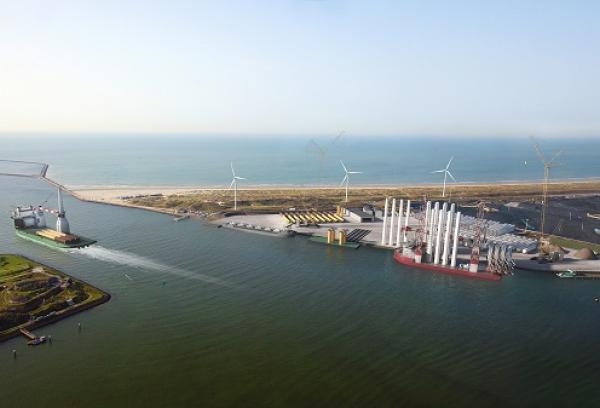New energy port for sustainable future

The dredge sludge depot at the former Averijhaven near IJmuiden will soon be developed into an Energy Port. A partnership covenant for the new facility was signed today by the Ministry of Infrastructure and Water Management, the Province of North Holland, the Municipality of Velsen, Tata Steel, IJmuiden Seaport and Port of Amsterdam.
The development of this new port is crucial for realising windfarms in the North Sea. The Energy Port forms an essential operational base for their construction and operational maintenance. It will, for example, provide support for building the windfarms Hollandse Kust West and IJmuiden Ver off the Dutch coast. The Energy Port also has an important role in realising the more intensive use of space and reinforcement of the regional port infrastructure, as planned.
The Energy Port is located on the sea side of the North Sea Canal, right before the IJmuiden lock complex. The new industrial estate offers great possibilities for meeting the needs of the energy transition, and advancing important regional and national climate change goals. By making an industrial estate of 5ha available, Tata Steel has shown its support for this future-looking initiative that’s so important for the region. What’s more, Tata Steel is allowing land access to the Energy Port through its site in Velsen North. This will enable the movement of personnel and access for emergency services.
Minster of Infrastructure and Water Management, Cora van Nieuwenhuizen, says, ‘The large-scale construction and operational maintenance of sustainable wind turbine farms in the North Sea demand a much greater port capacity. Our collaborative development of the Averijhaven into a modern energy port means that offshore businesses will have all the space they need in the future.’ The Energy Port will have an area of over 15ha. Both the existing acreage of the Averijhaven as well as the adjacent Tata Steel site of 5ha will be used to create a public port area for offshore wind. In the port area a quay will be installed of 580m – 200m as heavy duty facility with 12.5m water depth, and 380m standard facility with 10m water depth. The location of this port means that it will play an important role in the efficient installation and operational maintenance of wind farms, and save on costs.
Right now, the Energy Port is a Dutch government-owned dredge sludge depot. In order to transform this depot into a port area, the Dutch Directorate-General for Public Works and Water Management will have to clear it out first. In tandem with this necessary work, a study of the effects of constructing the Energy Port on the environment will be carried out by means of an Environmental Impact Assessment (EIA). A fundamental requirement is that the facility must fit within existing environmental guidelines. Commercial operation of the Energy Port will be run by Port of Amsterdam and IJmuiden Seaport on behalf of the other covenant partners. This commercial operation is in line with the strategic goals envisioned by both port authorities in terms of playing an active role in the national energy transition.






